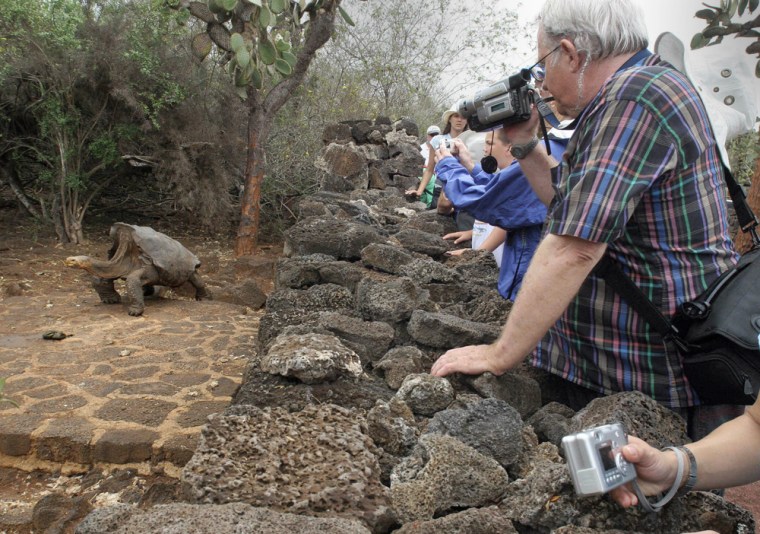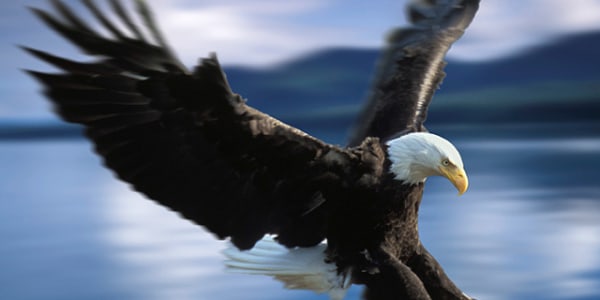Cruising to experience nature isn't necessarily a new idea. A certain part of the population has always gravitated to communing with the natural world in preference to the man-made one. Long before some wag coined the term "eco tourism," there were always adventurous souls among us who would rather climb a rock than buy one set in a platinum band, who choose paths over sidewalks, and caverns over subways, folks who will only tell you they're on top of the world when they are visiting above the Arctic Circle.
Though these folks are not new to travel and tourism, what is changing is that there seems to be more and more as each year passes. The expanded appeal is more than a burgeoning trend. Indeed, it is attributed, at least in part, to the embodiment of a quest by both passenger and cruise line to go off the beaten track -- hence Celebrity's foray into eco-cruising with its Galapagos-oriented Celebrity Xpedition.
For the passenger, craving something different, it's a possible next step after too many repeat sailings on industry core itineraries: Eastern, Western, Southern Caribbean, and the like.
From the cruise lines' perspective, sailings focused primarily on the wonders of the natural world offer a tempting entree into new niche markets.
Passionate about getting a close encounter with Mother Nature's best? Here are three basic formats from which to choose:
Expedition Cruises
These represent the purest way for the seagoing passenger to view nature. Generally speaking they share three attributes that makes them best suited for the task. First and foremost each ship has an onboard naturalist, deemed "expedition leader," with a specialty in the flora, fauna and geology of the region. In lieu of conventional cruise line entertainment, most onboard presentations are of an educational nature, meant to enrich the cruise experience and the passenger's knowledge.
The second primary attribute is flexibility of itinerary. Maybe the itinerary called for travel to a particular bay, but the captain or expedition director heir's reports of a large number of bears salmon fishing along the shore two bays down. Based on weather, wildlife sightings, season or events onshore, the itinerary may be modified or totally changed. On some vessels the expedition leader may even be equal in rank to the captain, whose primary nautical task is to navigate to the destinations the naturalist specifies.
Thirdly, most expedition vessels are quite small, able to fit into spots big ships' passengers can only get to on shore excursions. (Many expedition ships are no larger than the typical tour boat.) And though most expedition cruises offer optional shore excursions run by third parties, many carry smaller, crew- or self-driven vessels. While your ship may start out a visit to a calving glacier about the same distance as the megaliners, that may only be the dropping off point for Zodiac rafts that will approach to within a football field of the face of a glacier. Or, in the Sea of Cortez, you may go kayaking after dinner among a school of basking whale sharks.
Conventional Cruises With Shore Excursions
This is a format familiar to most Cruise Critic readers and aimed at the traveler who wants a healthy dose of nature without giving up the creature comforts and trappings of the big ships. In some ways it may be the best of both worlds but there's a caveat: Unlike with expedition-oriented cruise lines who incorporate the cost of shore adventures into the ticket price, on big ships you'll pay out of pocket for shore excursions -- and that can add up.
Combination Cruise/Land Tours
Regardless of your ship or cruising-style choices, though there are ample natural treasures within eyeshot of navigable waters, there are simply too many found inland for the serious nature lover to ignore: in Alaska it may be the vast reaches of Denali National Park; and your Indian Ocean cruise may be screaming for an African Safari add-on.
Here, by region, we offer our favorite picks:
Africa
What Not to Miss: No surprises here; Africa's natural treasure is its wild game. East Africa (Kenya, Uganda, and Tanzania) and South Africa (Botswana and South Africa) are the two preeminent areas for photo safaris. A bit more obscure are the Seychelle Islands, often included in African itineraries. The Seychelles are a haven for birders and under their clear seas snorkelers and scuba divers have lush reefs with ample sea life to view.
We recommend: African wildlife cannot adequately be viewed on a day excursion basis; a land add-on is required. Before the now defunct Renaissance started the ill-fated R-series, they had a wonderful two-week cruise/tour package: 11 days cruising the Seychelles combined with a 3-night safari in Kenya. Unfortunately, nobody currently offers that exact itinerary, but offers two South African land packages combinable with their African Cruise Itineraries: "Wildlife of Londolozi" (four-night pre- or post-cruise), and "Victoria Falls & Chobe Game Reserve, by Micato" (five-night post-cruise).
Slideshow 18 photos
Amazing Alaska
For those looking for something not so stratospheric price wise, check out Abercrombie & Kent's add-on East and South African safaris, combinable with their Nile River sailings. (www.abercrombiekent.com, 800-323-7308).
Alaska
What Not to Miss: Leaping salmon! Breaching whales! Soaring eagles! Grizzly bears! Calving glaciers! Actually, the list of what isn't there, naturally speaking, is shorter than the list of what is. Alaska is the naturalist's dream destination, a region where natural processes are taking place at such a rapid pace that you can stride across huge expanses of land that emerged from under hundreds of feet of glacial ice during your lifetime, or you can get intimate with a glaciers itself, hiking across crevasses or creeping up to its face in a Zodiac as it calves off new icebergs. For birders, eagles, puffins and other exotic birds are as common here as pigeons in New York. For those wanting to see or photograph aquatic mammals, Alaska's waterways throng with many species of seals and sea lions, as well as its most popular leviathans, the cetaceans: humpback and killer whales, as well as the smaller, but no less popular, dolphins and porpoises. For the best opportunities to see land species consider an add-on pre- or post-cruise visit to Denali National Park.
We Recommend: For the dedicated nature lover, an expedition cruise is the best way to explore Alaska's waterways. Why? First of all, the naturalist expedition leader will both expertly seek out the best nature-sighting opportunities and deliver educational enrichment lectures on what you are seeing. The smaller vessels can get into out-of-the-way spots to track down wildlife invisible to the big ships' passengers. Our pick for expedition cruising in Alaska is , simply because they have been doing it for so long and they have the largest fleet dedicated to the exploration of natural Alaska. In addition, they carry Zodiac inflatables for even closer visits with natural phenomena.
For those who don't want to give up the perks of the big ships we recommend a cruise/tour package with a finale in Denali booked with either or . The reason we pick these two lines is because they pretty much pioneered traditional cruising in Alaska and have the longest running relationships with local tourism operators, not to mention owning a substantial amount of their own infrastructure (each, for example, owns its own private rail cars for the Alaska Railroad).
The Galapagos Islands
What Not to Miss: The Galapagos Islands are a crucible of evolution and geology. Here both processes have been sped up dramatically, as the isolation of the islands cause rapid adaptation of species to the islands' unique environmental pressures. The Galapagos' most famous visitor, Charles Darwin, developed major portions of evolutionary theory by observing the diversity of the adaptation of bird species -- especially finches. Modern birders eagerly follow in his footsteps when they visit here. Along the islands' shores there are numerous shore and aquatic birds, including penguins, sharing their habitat with different types of seals and sea lions. And, of course, there are the reptiles that most people think of immediately when the Galapagos are mentioned: iguanas and giant tortoises. Amateur geologists will take more interest in the islands' location in one of the most active volcanic regions on earth -- the Nazca Plate, which is moving the islands toward South America at a blistering rate of 2.75 inches per year. (At the current rate the Galapagos should come crashing into the coast of Ecuador in the year 15208405 AD -- don't blink!)

Mexico's Sea of Cortez
What Not to Miss: The Sea of Cortez, a.k.a. the Gulf of California, has been referred to as "the world's biggest fish trap." Here tidal currents bring in a multitude of sea life from its confluence with the Pacific Ocean at Cabo San Lucas, and, sustained by the nutrient rich waters, they thrive, and either fail to be able to find their way back through the narrow opening, or simply choose not to. As a result there is a very long food chain, extending all the way from plankton to sperm whales. You can expect to see whales and perhaps whale sharks, and leaping giant Pacific manta rays. During the winter season, when the California Grey whales come to the Sea of Cortes to calve, you can expect, by Zodiac raft, to get almost within touching distance of these leviathans. For snorkelers there are numerous reefs, and there are even islands where you can snorkel or dive with sea lions.
We recommend: . They've been doing Baja for 20 years, and, although other cruise lines have expedition voyages there, Lindblad is nearly synonymous with the region. Committing their twin ships and (each carrying 70 guests, all in outside cabins), Lindblad maintains a presence in Baja throughout whale season -- and beyond -- January through July.
South Florida-based Faber is a longtime contributor to Cruise Critic and also columnist for Cruise Critic's Cruise News & Reviews. Beyond our publications, Faber's work has appeared in a myriad of outlets, including Cruise Travel Magazine, "The Miami Herald" and "The Total Traveler Guide to Worldwide Cruising."

